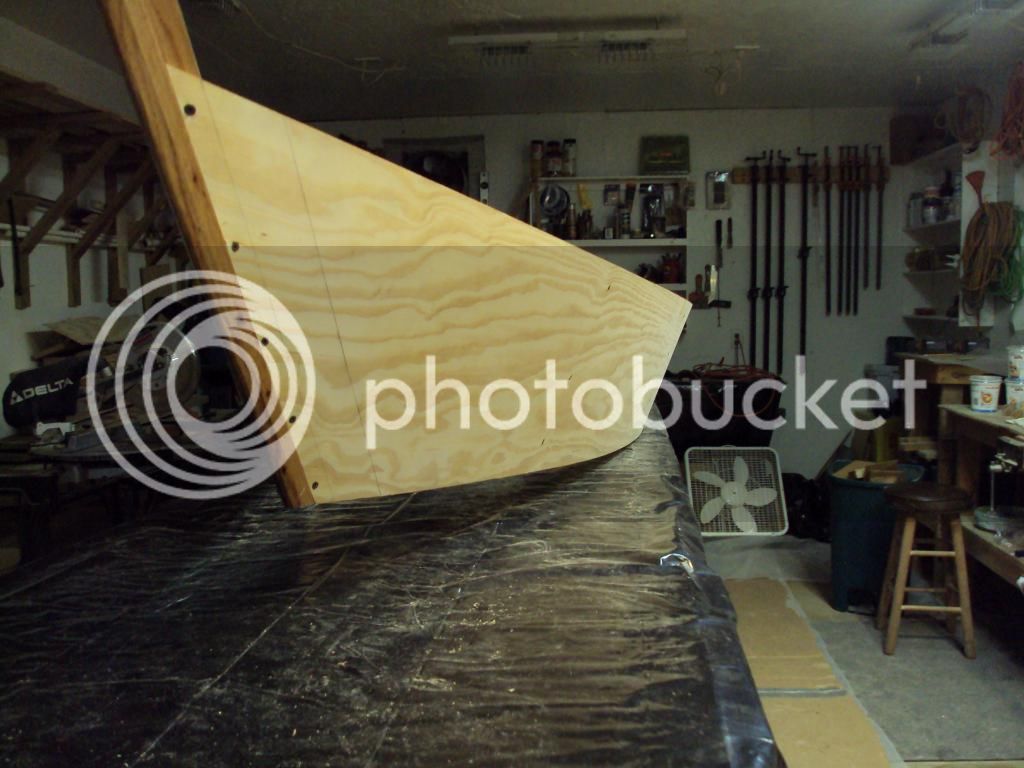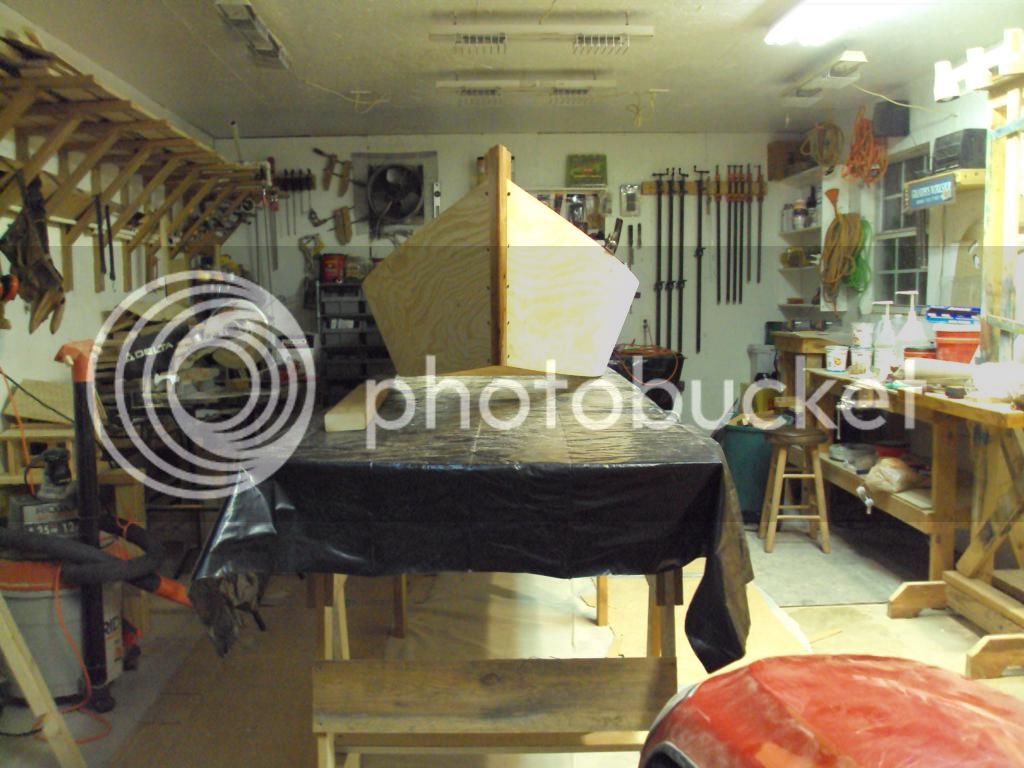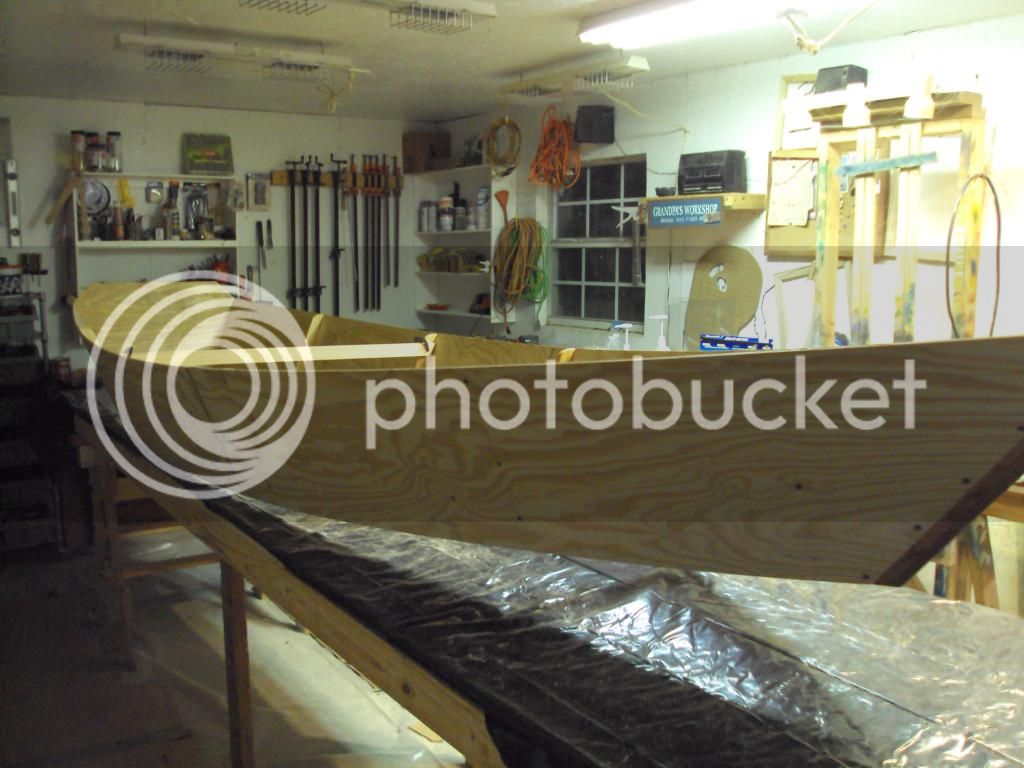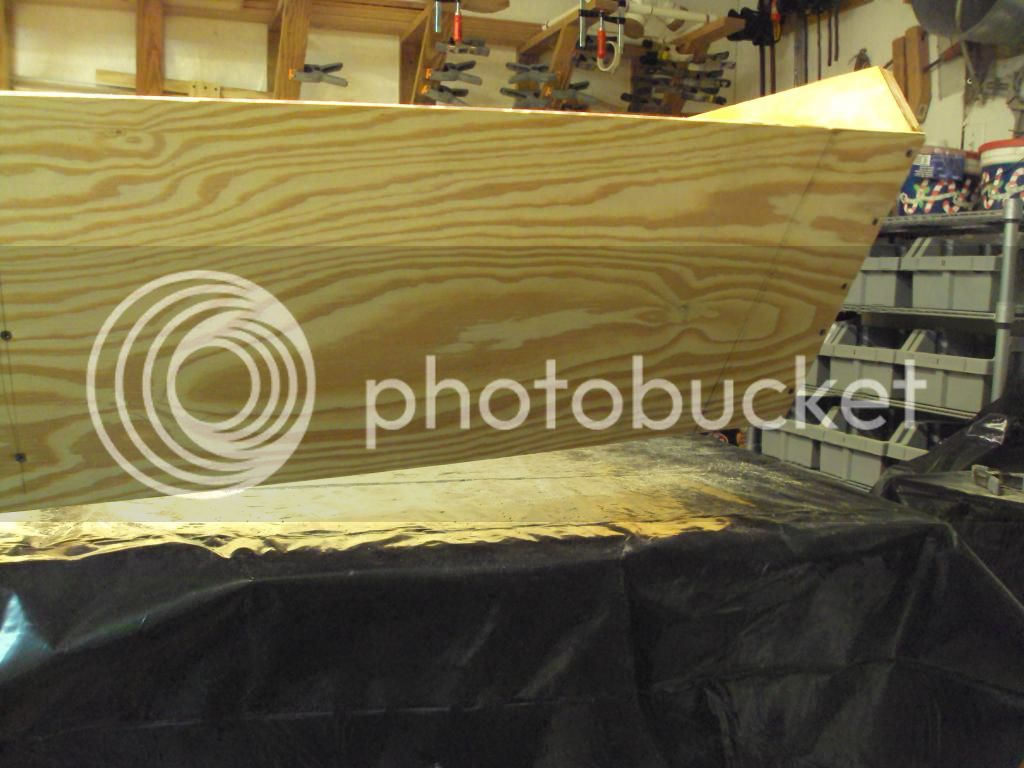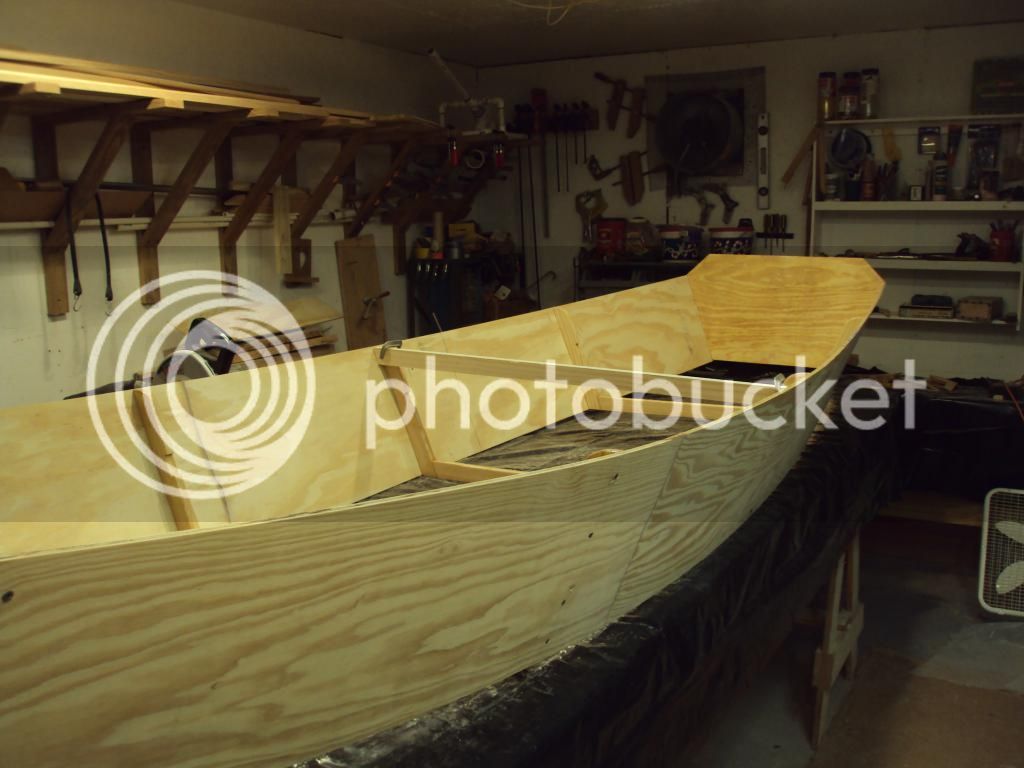Perry's Bayou Skiff Build
- Thread starter PerryM
- Start date
You are using an out of date browser. It may not display this or other websites correctly.
You should upgrade or use an alternative browser.
You should upgrade or use an alternative browser.
This is really coming along nicely! You're doing a great job with it. Can't wait to see the launch pics! 
Mike S.
Spring Hill, FL
Mike S.
Spring Hill, FL
Thank you Mike. I'm just about ready to break her down and epoxy saturate the parts. Been doing some reading about how to do that, or if its needed at all. The more I read, the more confused I become. Would love to get some thoughts on that. Is epoxy saturation needed? Should the epoxied be thinned? And if so, what's the best way to do that? By the way, I'm using non-blushing epoxy from Raka. Thanks again for all the help.
First, what do you mean by "breaking her down"? Once saturated, panels are difficult to bend. You will be a happier camper if you saturate an asembled boat that has already been glued into shape, sanded, and ready to be glassed. Plus, curing gives you only 3 days for the next coat of epoxy - the one holding on the glass - to bond chemically, not just mechanically.
Chuck will advise to saturate, let cure no more than a day, and sand off wood whiskers raised by the saturation coat. Good idea.
Thinning helps penetration. Acetonecan be used. Cautions: 1. Acetoneis highly flammable, and will burst into open flame if near an ignition source such as a gas furnace, water heater, or maybe even an electrcal heater. ("Mommy! Mommy! See the funny man run and wave his arms!"). Best done out doors. 2. Acetonecan enter the body through your skin. Don't get it on your skin. Don't drink it either. 3. Mix epoxy in small batches, 2-3 ounces total. Darned stuff creates its own heat and boils over. Boiling hot and very sticky - similar to napalm.
All that being said when you proceed with common sense and no jackassed behavior, its safe and produces lots of nice, strong, light-weight boats.
Chuck will advise to saturate, let cure no more than a day, and sand off wood whiskers raised by the saturation coat. Good idea.
Thinning helps penetration. Acetonecan be used. Cautions: 1. Acetoneis highly flammable, and will burst into open flame if near an ignition source such as a gas furnace, water heater, or maybe even an electrcal heater. ("Mommy! Mommy! See the funny man run and wave his arms!"). Best done out doors. 2. Acetonecan enter the body through your skin. Don't get it on your skin. Don't drink it either. 3. Mix epoxy in small batches, 2-3 ounces total. Darned stuff creates its own heat and boils over. Boiling hot and very sticky - similar to napalm.
All that being said when you proceed with common sense and no jackassed behavior, its safe and produces lots of nice, strong, light-weight boats.
I havn't sanded the sides, the epoxy on the ribs, or the bow stem which is already epoxied. Thought I would take her apart to do that since she is only screwed, but not glued, together. Should I saturate the areas of the sides where they connect to the transom and bow stem before screwing her together or since she is already together, do you think it would best easier to back the screws out some and glue her up?
Without standing there, looking at the boat, it's difficult to know exactly what you are taliking about.
General guidelines I use are: 1. All wood is sealed off from water by epoxy. Its called "encapsulating". 2. All seams are either taped or fileted prior to glassing, thus sealing off water at joints. A rounded filet lets the glass bend easily, and adhere to both inside and outside radii. 3. Epoxy companies failed to send along any runs, drips, or sags - so I always seem to install a few of my own.
General guidelines I use are: 1. All wood is sealed off from water by epoxy. Its called "encapsulating". 2. All seams are either taped or fileted prior to glassing, thus sealing off water at joints. A rounded filet lets the glass bend easily, and adhere to both inside and outside radii. 3. Epoxy companies failed to send along any runs, drips, or sags - so I always seem to install a few of my own.
What Jack said in the above post. 
To glue the boat you could back the screws out a bit and run some epoxy in the joint and then screw it back down.
As far as the saturation...............
Plus after saturating the wood some of the wood fibers will soak up the epoxy and become enlarged by standing out from the surface of the wood. They are what I like to call the wood whiskers and need to be removed before glassing the boat.
If you lay the glass down on them and move the glass they will pull on the glass and cause runs in it.
So a light sanding will remove them and let you move the glass around without damaging it. You do not need a 4 handed , 15 hoarse powered sander to remove them , just a piece of sand paper formed around a artificial sponge ( one of the rectangular ones ) will do it with a light swipe or two.
Run your hand over the wood ( Very , Very, Very lightly ) to see what I mean by the whiskers after you saturate the wood , then after one swipe with the sandpaper.
Chuck.
To glue the boat you could back the screws out a bit and run some epoxy in the joint and then screw it back down.
As far as the saturation...............
Plus after saturating the wood some of the wood fibers will soak up the epoxy and become enlarged by standing out from the surface of the wood. They are what I like to call the wood whiskers and need to be removed before glassing the boat.
If you lay the glass down on them and move the glass they will pull on the glass and cause runs in it.
So a light sanding will remove them and let you move the glass around without damaging it. You do not need a 4 handed , 15 hoarse powered sander to remove them , just a piece of sand paper formed around a artificial sponge ( one of the rectangular ones ) will do it with a light swipe or two.
Run your hand over the wood ( Very , Very, Very lightly ) to see what I mean by the whiskers after you saturate the wood , then after one swipe with the sandpaper.
Chuck.
About "saturation." I think in general that the term is used rather lightly. The original version of "epoxy saturation" was using very thin sheets of a porous, dry wood and very thin epoxy to make your own "plywood." Most any shaped hull could easily be made into a truly single piece of plywood, no seams at all.
The type of building you are doing doesn't really go that far. Even thinned with acetone, you are unlikely to get full penetration of the outermost veneer. And if it should go as far as the first glue line, it will go no further. So what you are doing is more properly described as "epoxy encapsulation," as was mentioned earlier.
And it works great!
Mike S.
Spring Hill, FL
The type of building you are doing doesn't really go that far. Even thinned with acetone, you are unlikely to get full penetration of the outermost veneer. And if it should go as far as the first glue line, it will go no further. So what you are doing is more properly described as "epoxy encapsulation," as was mentioned earlier.
And it works great!
Mike S.
Spring Hill, FL
Now I'm totally confused. :shock: LOL In simple, first time builder, layman's terms... should I thin my epoxy for the saturation coat? And if so, what is the ratio of epoxy and hardener to acetone? When using epoxy to glue the ribs to the sides, should I add a thickener such as wood flour or silica? That's the two I have on hand. 
1....You don't need to thin the epoxy to use it for the saturation coat.should I thin my epoxy for the saturation coat?
2....If you would decide to thin it then use what ever mix you like to work with. Remember acetone evaporates really quick so the mix would get back to the original thickness , it's something to play with till you get it to your liking.
1....When using the epoxy to glue the ribs and rest in place just use the normal mix with nothing added to it.When using epoxy to glue the ribs to the sides, should I add a thickener such as wood flour or silica
2....If there is a gap in a joint then you can come back and mix some epoxy with wood flour ( or whatever you like ) to be used as a filler.
PerryM said:Thanks for clearing that up for me. Yall saved me lots of work. I'll post more pics soon.
Building the 1st boat is always a learning curve and no matter how or what you did after completing it you will stand there looking at it and say ...I should of done this or that. It is a continuing learning process.
Looking at the happy side of the coin , you will have a boat you made to enjoy and use while arguing with your self about which one to build next.
Heck , sometimes that ( I should of done this or that ) even happens later when more are made but always after the 1st one. :lol:
Chuck.
Hey gang... checking in here and of course I have questions. LOL Got the ribs glued in with epoxy. It was a little messy but much easier than I thought it would be. Had some screws ( drywall screws) break off while removing them from the oak bow stem. Other than that it went well.
Due to the way my bow deck and rub rails are designed, I felt it would be much easier to glass the inside section from the bow to the first rib before installing the rub rails and deck. When the pics are posted it will make more sense, hopefully. Anyway, I did that today and now I have some questions.
1. If using plastic cups to mix the epoxy, how many times can you use the same cup or should you use a new one for each batch?
2. I've been using those cheap throw away brushes which seems to harden up pretty quickly. Cleaning them with vinegar hasn't worked well at all. Is there anything else that might work other than acetone?
3. How many coats of epoxy do you recommend to fill the weave and build up the final thickness? I read on here somewhere that you can use less coats if you add silica to the expoxy. (as long as you plan on painting the boat). Any thoughts?
4. When laying the glass between the ribs, do you stop at the fillet or can you run the glass past the fillet and on to the side of the rib?
(hope you can cuz thats how I did it today)
Finally... I'm having a blast building this boat! My advice to anyone considering building there own boat is to go for it!
And again, thanks for all your help and suggestions!
Due to the way my bow deck and rub rails are designed, I felt it would be much easier to glass the inside section from the bow to the first rib before installing the rub rails and deck. When the pics are posted it will make more sense, hopefully. Anyway, I did that today and now I have some questions.
1. If using plastic cups to mix the epoxy, how many times can you use the same cup or should you use a new one for each batch?
2. I've been using those cheap throw away brushes which seems to harden up pretty quickly. Cleaning them with vinegar hasn't worked well at all. Is there anything else that might work other than acetone?
3. How many coats of epoxy do you recommend to fill the weave and build up the final thickness? I read on here somewhere that you can use less coats if you add silica to the expoxy. (as long as you plan on painting the boat). Any thoughts?
4. When laying the glass between the ribs, do you stop at the fillet or can you run the glass past the fillet and on to the side of the rib?
(hope you can cuz thats how I did it today)
Finally... I'm having a blast building this boat! My advice to anyone considering building there own boat is to go for it!
And again, thanks for all your help and suggestions!
Opinions will vary. As you progress, use boats in different situations, see other boats, talk with other builders, etc. - your opinions will vary too.
"Filling the weave" adds weight, and each successive coat adds some strength. Albeit, probably less and less strength. I like the floor of a boat to not be glassy and slick, so am not very interested in completely filling weave where I want traction.
Running some glass part way up the side of ribs will strengthen those joints. And, joints are traditionally weak points in structures.
A useful technique to use with those clear, plastic cups, is to use two at a time. Here's how. Stack two cups together, one inside the other. Put a strip of tape up the side of the outside cup. Set them on a level surface, and pour an ounce of water into the INSIDE cup. Mark the tape, and lable it as 1. Do the same, ounce by ounce, up the side.
NEVER put epoxy in the cup with tape on it. ALWAYS put a new, clean cup inside, put in resin and hardener into the inside cup, using your precalibrated marks on the outside cup. For smaller batches, you may need to have some 1/2 ounce marks. Use measurement to establish these; don't try to eyeball it. The sides of the cup aren't straight, but sloped. Volume isn't directly proportional to height.
Use a clean cup for every batch. Reuse the outside cup a lot of times. Once in a while, I use one of the clean cups for an adult beverage. But - only under duress.
"Filling the weave" adds weight, and each successive coat adds some strength. Albeit, probably less and less strength. I like the floor of a boat to not be glassy and slick, so am not very interested in completely filling weave where I want traction.
Running some glass part way up the side of ribs will strengthen those joints. And, joints are traditionally weak points in structures.
A useful technique to use with those clear, plastic cups, is to use two at a time. Here's how. Stack two cups together, one inside the other. Put a strip of tape up the side of the outside cup. Set them on a level surface, and pour an ounce of water into the INSIDE cup. Mark the tape, and lable it as 1. Do the same, ounce by ounce, up the side.
NEVER put epoxy in the cup with tape on it. ALWAYS put a new, clean cup inside, put in resin and hardener into the inside cup, using your precalibrated marks on the outside cup. For smaller batches, you may need to have some 1/2 ounce marks. Use measurement to establish these; don't try to eyeball it. The sides of the cup aren't straight, but sloped. Volume isn't directly proportional to height.
Use a clean cup for every batch. Reuse the outside cup a lot of times. Once in a while, I use one of the clean cups for an adult beverage. But - only under duress.
Jacks idea with the cups to mix the epoxy is good but if you have the dispersing pumps on the epoxy and hardener jugs then just use one cup , mix the epoxy and I like to put it in a disposable paint tray. That way it spreads out and will not cure as fast letting you use all of it.
Epoxy confined to a small space will set up a lot quicker and get hot on you.
I used the cheep bristle brushes and even the foam ones for the detail work or small projects , the foam ones tend to fall apart if you try to use them for to long. The bristle ones will lose some bristle if the epoxy starts to set up. Most of the time I never bothered to clean them , they are disposable. If or when I did clean them it was with some acetone.
For glassing the boats I used the rollers made for epoxy ( Found them at Home Depot , paint section ) They are 9 inches long so I used a 4 inch holder for them. Took each 9 inch roller and cut it to 4 1/2 inches with a sharp razor knife. This way I got 2 rollers for the price of one.
Using the paint tray I could mix the epoxy , put it in the paint tray and using the roller , roll out the batch of epoxy onto the glass , then mix another double batch and repeat the process till I got the inside of the boat glassed. Same for the outside of the boat , normally the next day.
Then with a handful of paper towels I would grab the roller and remove it from the holder and add the roller and paper towels to my trash bag.
The disposable paint tray was left alone and the next day I would bend it and the cured epoxy would fall out , sometimes I had to check for drops that cured and were stuck to the tray but most of the time I could reuse the tray several times.
Also if i am mixing anything in the epoxy I add it to the epoxy and mix it , when it is mixed to the consistency I want then I add the hardener to it and mix it all together , ( The hardener , when added , does thin the mix down ) that way is does not start to set up till the hardener is added.
Epoxy confined to a small space will set up a lot quicker and get hot on you.
I used the cheep bristle brushes and even the foam ones for the detail work or small projects , the foam ones tend to fall apart if you try to use them for to long. The bristle ones will lose some bristle if the epoxy starts to set up. Most of the time I never bothered to clean them , they are disposable. If or when I did clean them it was with some acetone.
For glassing the boats I used the rollers made for epoxy ( Found them at Home Depot , paint section ) They are 9 inches long so I used a 4 inch holder for them. Took each 9 inch roller and cut it to 4 1/2 inches with a sharp razor knife. This way I got 2 rollers for the price of one.
Using the paint tray I could mix the epoxy , put it in the paint tray and using the roller , roll out the batch of epoxy onto the glass , then mix another double batch and repeat the process till I got the inside of the boat glassed. Same for the outside of the boat , normally the next day.
Then with a handful of paper towels I would grab the roller and remove it from the holder and add the roller and paper towels to my trash bag.
The disposable paint tray was left alone and the next day I would bend it and the cured epoxy would fall out , sometimes I had to check for drops that cured and were stuck to the tray but most of the time I could reuse the tray several times.
Also if i am mixing anything in the epoxy I add it to the epoxy and mix it , when it is mixed to the consistency I want then I add the hardener to it and mix it all together , ( The hardener , when added , does thin the mix down ) that way is does not start to set up till the hardener is added.


